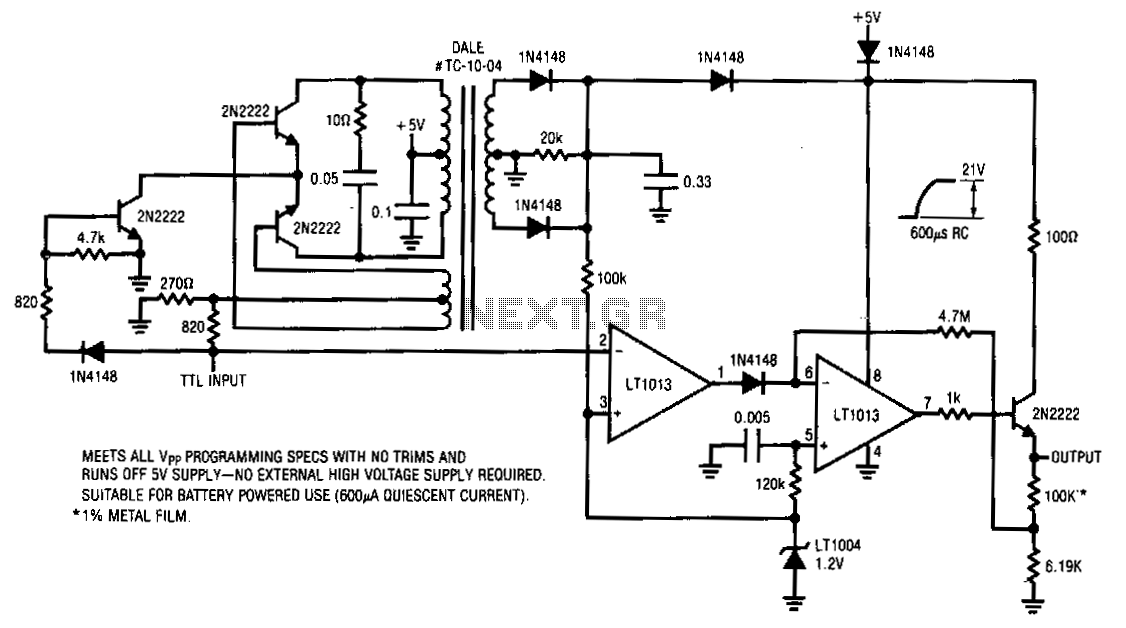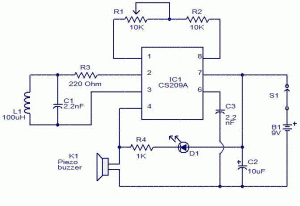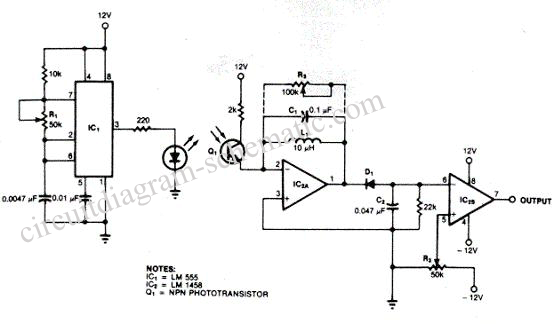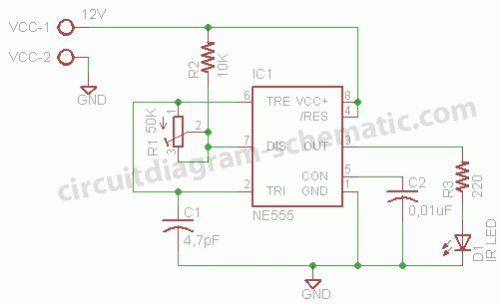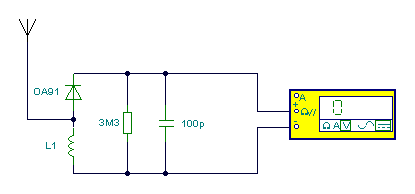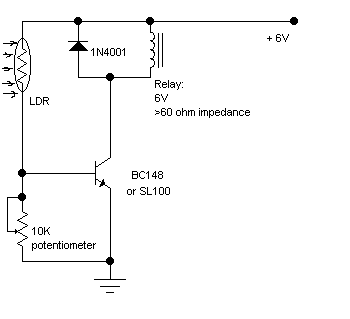
Electromagnetic Field Detector
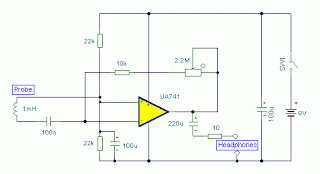
This detector circuit is sensitive to low-frequency electromagnetic radiation and can detect hidden wiring or the field around a transformer. The pickup is achieved using a radial type inductor, which serves as a probe that responds effectively to low-frequency changing magnetic and electric fields. Ordinary headphones are utilized for detection. The field surrounding a transformer is perceived as a 50 or 60 Hz buzz. A length of screened cable is threaded through an old pen tube, with the ends soldered to a radial type can inductor rated at 1 mH. The inductor fits snugly into the pen tube, while the opposite end of the cable connects to the input of the operational amplifier (op-amp). Any op-amp can be employed, although better results may be obtained with a low-noise FET type such as the LF351. A 2.2 MΩ potentiometer functions as a gain control, and the output is directed to a pair of headphones. Stereo headphones may be used if wired as mono. An 8-ohm type was used, but the circuit should also work with higher impedance types. The probe can be connected via screened cable and a 3.5 mm stereo plug and socket. The detection sensitivity of this circuit is commendable; mains wiring buried an inch in plaster can be detected accurately. A small load on the electric supply, such as a 20-watt desk lamp, is sufficient. The hum field surrounding a transformer can be detected from over 7 inches away. Domestic appliances, including video players and alarm clocks, produce interference that can be detected with the probe. The electric field around a loudspeaker or earpiece is also audible. For example, placing the probe near the earpiece of a telephone will yield results. A telephone pickup coil can be substituted for the inductor if desired. An improved version of this circuit with a meter output will be developed in the future.
This detector circuit is designed to effectively sense low-frequency electromagnetic radiation, making it suitable for applications such as locating hidden wiring or identifying electromagnetic fields produced by transformers. The core component of the circuit is a radial type inductor, which functions as a probe capable of detecting low-frequency variations in magnetic and electric fields.
The circuit utilizes ordinary headphones for audio output, allowing for real-time monitoring of detected signals. The audible output from the circuit manifests as a 50 or 60 Hz buzz when detecting the electromagnetic field around transformers, which is a common frequency in power systems.
The construction of the probe involves threading a length of screened cable through a pen tube, ensuring that the inductor is securely housed. The inductor, with a value of 1 mH, is soldered to the ends of the cable, providing stability and ease of use. The opposite end of the cable connects to the input of an operational amplifier, which amplifies the detected signals for better audibility. While any operational amplifier can be used, a low-noise FET type like the LF351 is recommended for enhanced performance.
A 2.2 MΩ potentiometer is incorporated into the design to allow for gain adjustment, enabling users to fine-tune the sensitivity of the circuit based on the specific detection environment. The output is directed to headphones, with the option to use stereo headphones wired for mono operation. The circuit is compatible with various headphone impedances, although an 8-ohm type is specified for optimal performance.
The probe can easily connect to the circuit via screened cable and a 3.5 mm stereo plug and socket, facilitating straightforward integration and use. The sensitivity of the circuit is noteworthy, with the ability to detect mains wiring buried as deep as one inch in plaster. A minimal load on the electrical supply, such as a 20-watt desk lamp, is adequate for operation.
The circuit also demonstrates the capability to detect the hum field around transformers from distances exceeding 7 inches, making it a practical tool for identifying electromagnetic interference from domestic appliances like video players and alarm clocks. Additionally, the circuit can detect the electric fields surrounding audio devices, such as loudspeakers and earpieces. For instance, placing the probe near a telephone's earpiece will yield audible signals.
For users seeking alternative configurations, a telephone pickup coil can be utilized in place of the radial inductor, offering flexibility in design. Future enhancements to the circuit may include the addition of a meter output for more precise measurements of detected signals, further expanding its functionality and application scope.This detector circuit is sensitive to low frequency electromagnetic radiation and will detect for example hidden wiring or the field that encompasses a transformer. Pickup is by a radial type inductor, used as a probe which responds well to low frequency changing magnetic and electric fields.
Ordinary headphones are used to for detection. The fiel d that surrounds a transformer is heard as a 50 or 60Hz buzz. I threaded a length of screened cable through an old pen tube and soldered the ends to a radial type can inductor. I used 1mH. The inductor fitted snugly into the pen tube. The opposite end of the cable connects to the input of the opamp. Any opamp should work here, possibly better results may be achieved with a low noise FET type such as the LF351.
The 2M2 potentiometer acts as a gain control and the output is a pair of headphones. Stereo types can be used if they are wired as mono. I used an 8 ohm type, but the circuit should work equally well with higher impedance types. The probe (shown below) may be connected via screened cable and a 3. 5mm stereo plug and socket. The detection sensitivity of this circuit is good. Mains wiring buried an inch in plaster can be detected with precision. A small load on the electric supply is all that is needed; a 20 watt desk lamp or similar will suffice. The hum field surrounding a transformer can be detected oat over 7 inches. Domestic appliances such as videos and alarm clocks all produce interference which can be heard with the probe.
The electric field surrounding a loudspeaker or earpiece can also be heard. Try lifting a telephone and place the probe near the earpiece. A telephone pickup coil can be used in place of the inductor if desired. I will make an improved version of this circuit with a meter output later. 🔗 External reference
This detector circuit is designed to effectively sense low-frequency electromagnetic radiation, making it suitable for applications such as locating hidden wiring or identifying electromagnetic fields produced by transformers. The core component of the circuit is a radial type inductor, which functions as a probe capable of detecting low-frequency variations in magnetic and electric fields.
The circuit utilizes ordinary headphones for audio output, allowing for real-time monitoring of detected signals. The audible output from the circuit manifests as a 50 or 60 Hz buzz when detecting the electromagnetic field around transformers, which is a common frequency in power systems.
The construction of the probe involves threading a length of screened cable through a pen tube, ensuring that the inductor is securely housed. The inductor, with a value of 1 mH, is soldered to the ends of the cable, providing stability and ease of use. The opposite end of the cable connects to the input of an operational amplifier, which amplifies the detected signals for better audibility. While any operational amplifier can be used, a low-noise FET type like the LF351 is recommended for enhanced performance.
A 2.2 MΩ potentiometer is incorporated into the design to allow for gain adjustment, enabling users to fine-tune the sensitivity of the circuit based on the specific detection environment. The output is directed to headphones, with the option to use stereo headphones wired for mono operation. The circuit is compatible with various headphone impedances, although an 8-ohm type is specified for optimal performance.
The probe can easily connect to the circuit via screened cable and a 3.5 mm stereo plug and socket, facilitating straightforward integration and use. The sensitivity of the circuit is noteworthy, with the ability to detect mains wiring buried as deep as one inch in plaster. A minimal load on the electrical supply, such as a 20-watt desk lamp, is adequate for operation.
The circuit also demonstrates the capability to detect the hum field around transformers from distances exceeding 7 inches, making it a practical tool for identifying electromagnetic interference from domestic appliances like video players and alarm clocks. Additionally, the circuit can detect the electric fields surrounding audio devices, such as loudspeakers and earpieces. For instance, placing the probe near a telephone's earpiece will yield audible signals.
For users seeking alternative configurations, a telephone pickup coil can be utilized in place of the radial inductor, offering flexibility in design. Future enhancements to the circuit may include the addition of a meter output for more precise measurements of detected signals, further expanding its functionality and application scope.This detector circuit is sensitive to low frequency electromagnetic radiation and will detect for example hidden wiring or the field that encompasses a transformer. Pickup is by a radial type inductor, used as a probe which responds well to low frequency changing magnetic and electric fields.
Ordinary headphones are used to for detection. The fiel d that surrounds a transformer is heard as a 50 or 60Hz buzz. I threaded a length of screened cable through an old pen tube and soldered the ends to a radial type can inductor. I used 1mH. The inductor fitted snugly into the pen tube. The opposite end of the cable connects to the input of the opamp. Any opamp should work here, possibly better results may be achieved with a low noise FET type such as the LF351.
The 2M2 potentiometer acts as a gain control and the output is a pair of headphones. Stereo types can be used if they are wired as mono. I used an 8 ohm type, but the circuit should work equally well with higher impedance types. The probe (shown below) may be connected via screened cable and a 3. 5mm stereo plug and socket. The detection sensitivity of this circuit is good. Mains wiring buried an inch in plaster can be detected with precision. A small load on the electric supply is all that is needed; a 20 watt desk lamp or similar will suffice. The hum field surrounding a transformer can be detected oat over 7 inches. Domestic appliances such as videos and alarm clocks all produce interference which can be heard with the probe.
The electric field surrounding a loudspeaker or earpiece can also be heard. Try lifting a telephone and place the probe near the earpiece. A telephone pickup coil can be used in place of the inductor if desired. I will make an improved version of this circuit with a meter output later. 🔗 External reference
